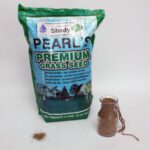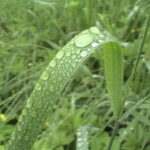Weeds spoil the look of a lush green lawn, but with care you can keep your lawn free from unsightly weeds using a range of natural preventative measures.
What are lawn weeds?
Any plant that competes with grass originally established to create a lawn can be considered a weed.
Sometimes, flowering annuals that self-seed freely will drop their seed into bare patches in the lawn, and even though they are pretty, they spoil the smooth, even green surface that has been created.
More damaging are the broad-leaf weeds, such as Dandelion and Dock, which spread quickly and are hard to remove.
Other common weeds in the lawn include Bindi-eye, which is spiky and makes walking barefoot on the grass impossible, and Common Clover, which has rounded leaves and small cream flowers.
Winter Grass and Nut Grass are also problems in some areas and they too are difficult to eradicate. Moss, which occurs in shady lawn areas, is also considered a problem by some gardeners.
How can I control this weed growth?
The best way to prevent weeds from becoming established in the lawn is to create an environment in which it is difficult for them to germinate or take root. If the lawn is kept thick and lush, with no bare patches, the weeds will find it hard to infiltrate.
Routine watering, feeding and mowing during the main growing season is the best way to keep the lawn thick and weed-proof.
Those areas of the lawn where the soil is compacted will also become bare and therefore vulnerable to weed infestation.
If weeds do appear, remove them rapidly before they have a chance to spread and keep a look out for annual weeds that flower and go to seed. Remove these annual weeds before the flower heads have a chance to mature.
How do weeds spread?
Most weeds are spread from seed, which scatter in the wind or are dropped by birds to germinate in any patch of exposed soil.
In lawns with bare patches, weed problems will occur more rapidly. Weed seeds will take advantage of the exposed soil surface to get established.
Some weeds, such as Buttercups, are spread by runners which rapidly emerge from parent plants and take root in the lawns.
Below are four ways to control weeds. You will require:
- Mower
- Topsoil and lawn seed
- Lawn clippings
- Fertilizer
1. Do not mow the lawn too close, as it exposes bare parches of soil in which weed seeds can germinate. The lawn should be kept at about 5cm.
2. If bare patches appear from thatching, compaction or disease, patch them quickly with topsoil and fresh lawn seed, before weeds invade.
3. Lawn clippings should be composted to destroy possible weed seeds which can germinate if allowed to remain lying around in the garden.
4. Apply fertilizer that has a broad-leaf weed-killer incorporated to keep the lawn lush and to keep the broad-leaf weeds under control.
You can also control weeds manually. Use a broad-leaf weeding tool to lift weeds such as Dock and Dandelion from the lawn as they appear. Make sure you get the whole root as well as the top of the weed.
Many weeds develop flowers and seed heads rapidly. Remove systematically to prevent seed from scattering in the wind.
Routine lawn maintenance is the best way to prevent weeds from taking over your lawn. Watering, feeding and mowing regularly are essential.
Adjust the lawnmower blades to a high setting in order to prevent ‘shaving’ the lawn close to ground level. Frequent ‘high’ mowing is the best way to prevent weeds from establishing. The ideal height for your lawn is approximately 5 cm high.






